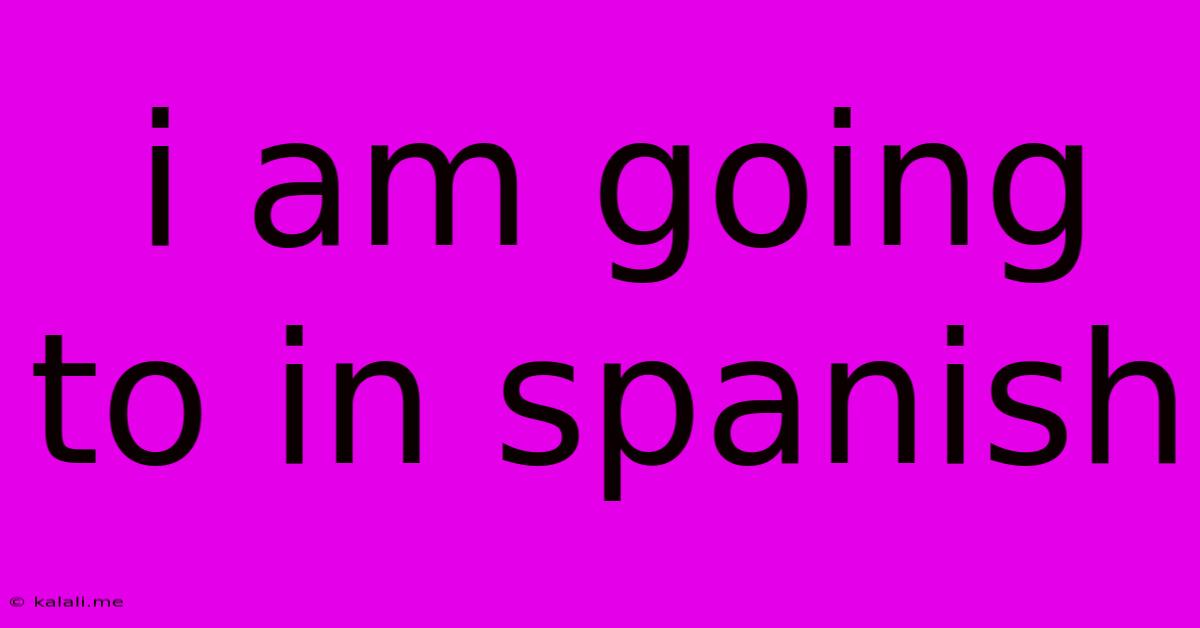I Am Going To In Spanish
Kalali
May 30, 2025 · 3 min read

Table of Contents
I'm Going To in Spanish: Mastering the Future Tense
Going somewhere? Planning an event? Expressing your future plans in Spanish is easier than you think! This guide will unravel the nuances of expressing "I'm going to" in Spanish, covering various contexts and ensuring you sound like a native speaker. This will help you confidently navigate everyday conversations and plan your next Spanish adventure.
Understanding the Nuances of "I'm Going To"
In English, "I'm going to" (often shortened to "gonna") signifies intention or a planned future action. Spanish, however, offers a few ways to express this, depending on the level of certainty and formality. We'll explore the most common methods:
-
Ir a + infinitive: This is the most common and versatile way to express "I'm going to" in Spanish. The verb "ir" (to go) conjugated in the present tense, followed by the infinitive of the verb expressing the planned action.
- Example: "Voy a comer" (I'm going to eat). "Vamos a bailar" (We're going to dance). "Ella va a viajar" (She's going to travel).
-
Near Future Tense (using ir + a + infinitive): This construction provides a more immediate sense of the future action, emphasizing the intention to do something very soon.
- Example: "Voy a salir ahora mismo." (I'm going to leave right now.)
-
Present Tense for Scheduled Events: For pre-arranged plans, the present tense can sometimes be used instead of the future tense. This is particularly common when discussing firmly scheduled events.
- Example: "Mañana salgo a las ocho." (I'm leaving at eight tomorrow.) The present tense here effectively communicates a future action because the time is clearly specified.
Choosing the Right Option: Context is Key
The best way to express "I'm going to" in Spanish depends heavily on context. Consider these factors:
- Immediacy: For immediate plans, use ir a + infinitive.
- Certainty: If the plan is highly certain, ir a + infinitive is suitable. For less certain plans, consider using the conditional tense.
- Formality: The ir a + infinitive construction works well in both formal and informal settings.
Beyond the Basics: Expanding Your Vocabulary
While mastering ir a + infinitive is crucial, incorporating related vocabulary enhances your ability to express future plans naturally. Consider these examples:
- Tengo pensado + infinitive: This translates to "I'm planning to..." It adds a nuance of planning and consideration. Example: "Tengo pensado viajar a España el próximo año." (I'm planning to travel to Spain next year.)
- Quiero + infinitive: This signifies "I want to..." It expresses a desire for future action. Example: "Quiero aprender a bailar flamenco." (I want to learn to dance flamenco).
- Espero + infinitive: This means "I hope to..." suggesting a less certain future plan. Example: "Espero visitar la Alhambra." (I hope to visit the Alhambra.)
Practical Application: Putting it All Together
Let's solidify your understanding with some practical examples:
- I'm going to study Spanish: Voy a estudiar español.
- I'm going to visit my family: Voy a visitar a mi familia.
- We're going to eat paella: Vamos a comer paella.
- She's going to learn to cook: Ella va a aprender a cocinar.
- He's going to travel to South America: Él va a viajar a Sudamérica.
By understanding these variations and practicing their usage, you'll be well-equipped to express your future plans in Spanish with confidence and fluency. Remember to consider the context and level of certainty when choosing the most appropriate phrase. ¡Buena suerte! (Good luck!)
Latest Posts
Latest Posts
-
How To Change The Cover Of A Paper Spiral Notebook
May 31, 2025
-
How Do I Connect A Dishwasher
May 31, 2025
-
Does Cloudy Clear Coat Go Away
May 31, 2025
-
Turn Levels Of White Into Transparency
May 31, 2025
-
What Happened To Bon Clay After Impel Down
May 31, 2025
Related Post
Thank you for visiting our website which covers about I Am Going To In Spanish . We hope the information provided has been useful to you. Feel free to contact us if you have any questions or need further assistance. See you next time and don't miss to bookmark.